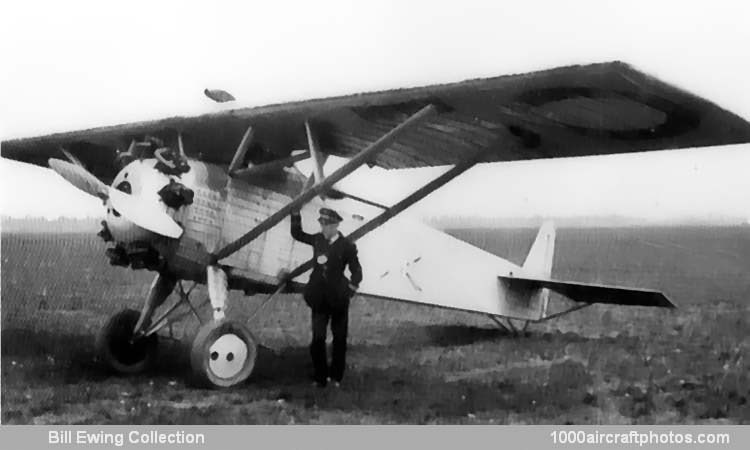09/30/2011. Remarks by Johan Visschedijk: "To meet the requirements of the 1923 C1 (Avion monoplace de chasse) specification issued by the STAé (Section Technique de l'Aéronautique), Avions Michel Wibault tendered the Wibault 7 C1 as one of 12 competing fighters submitted by six manufacturers. Like the preceding Wibault 3, the Wibault 7 employed the Wibault-patented system of light alloy construction and was powered by a 480 hp Gnome & Rhône 9Ad Jupiter nine-cylinder air-cooled radial engine, armament consisting of two synchronized 0.303 in (7.7 mm) Vickers machine guns.
Designed by M. Martinet, the Wibault 7 was first flown in 1924, and was joined in the following year by a second, modified prototype which was to undergo performance trials at Villacoublay during August 1925. Powered by a 420 hp Gnome & Rhône 9Ac engine, the second prototype featured a redesigned landing gear, reinforced wing bracing, a redesigned vertical tail and replacement of the smooth fuselage Dural paneling by corrugated sheet.
The two synchronized fuselage-mounted guns were augmented by two wing-mounted 0.303 in (7.7 mm) Darne 1919 guns, and this prototype demonstrated 145 mph (234 kmh) at 13,125 ft (4 000 m) during Villacoublay trials. The Nieuport-Delage 42 and the Gourdou-Leseurre 32 were respectively adjudged first and second among the dozen contenders, each being awarded a 25-aircraft contract. Surprisingly, the Wibault 7, which took eleventh place in the contest, was recipient of a similar contract which was placed in January 1927.
A third Wibault 7 prototype had meanwhile been completed, and the 25 pre-series differed from the second and third prototypes primarily in discarding the wing-mounted guns, deliveries commencing in 1928 to the two escadrilles de chasse of the 32e Régiment d'Aviation Mixte. Earlier, in November 1925, one Wibault 7 powered by a 455 hp Bristol Jupiter VI had been dispatched to the UK as a prototype of the Vickers Type 121. One airframe fitted in 1926 with a 400 hp Hispano-Suiza 12Jb twelve-cylinder V-engine for comparison purposes as the Wibault 71 was redesignated Wibault 9 before completion.
A follow-on order for the Aviation Militaire involved 60 Wibault 72s which differed from the Wibault 7 solely in having some strengthening of the wing structure. The Wibault 72s were delivered to the 32e Regiment, which, on October 1, 1932, became the 7e Escadre de Chasse with a complement of four escadrilles and 45 Wibault 72s. Following demonstration in Poland of the third pre-series Wibault 7 in 1925, a license was obtained for the manufacture of 30 aircraft by PZL, 26 of these being completed as Wibault 72s and four as Wibault 73s. The latter differed in having the 450 hp Lorraine-Dietrich 12EB twelve-cylinder "broad-arrow" type liquid-cooled engine.
Seven Wibault 73s were supplied in 1929 to Paraguay's Fuerzas Aéreas Nacionales, equipping the 1er Escuadrón de Caza, but proved troublesome, only three remaining when full-scale warfare between Paraguay and Bolivia began in June 1932. In April 1929, one Wibault 7 was flown experimentally aboard the carrier Béarn by Escadrille 7C1, leading to an order for eighteen aircraft for the Aviation Maritime. Designated Wibault 74, the navalized model was fitted with an arrester hook and the wing was moved marginally aft to adjust the center of gravity. The Wibault 74s were delivered in March 1932 to Escadrille 7C1 which retained them until 1938."
